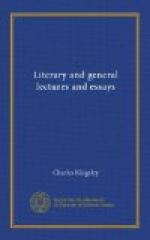And again, vol. ii. p. 4:
The legend of St. George came to us from the East; where, under various forms, as Apollo and the Python, as Bellerophon and the Chimaera, as Perseus and the Sea-monster, we see perpetually recurring the mythic allegory by which was figured the conquest achieved by beneficent Power over the tyranny of Wickedness, and which reappears in Christian art in the legends of St. Michael and half a hundred other saints.
To us these stories seem to have had by no means an allegorical, but rather a strictly historic foundation; and our reasons for this opinion may possibly interest some readers.
Allegory, strictly so called, is the offspring of an advanced, and not of a semi-barbarous state of society. Its home is in the East— not the East of barbarous Pontine countries peopled by men of our own race, where the legend of St. George is allowed to have sprung up, but of the civilised, metaphysical, dark-haired races of Egypt, Syria, and Hindostan. The “objectivity” of the Gothic mind has never had any sympathy with it. The Teutonic races, like the earlier Greeks, before they were tinctured with Eastern thought, had always wanted historic facts, dates, names, and places. They even found it necessary to import their saints; to locate Mary Magdalene at Marseilles, Joseph of Arimathea at Glastonbury, the three Magi at Cologne, before they could thoroughly love or understand them. Englishmen especially cannot write allegories. John Bunyan alone succeeded tolerably, but only because his characters and language were such as he had encountered daily at every fireside and in. every meeting-house. But Spenser wandered perpetually away, or rather, rose up from his plan into mere dramatic narrative. His work and other English allegories, are hardly allegoric at all, but rather symbolic; spiritual laws in them are not expressed by arbitrary ciphers, but embodied in imaginary examples, sufficiently startling or simple to form a plain key to other and deeper instances of the same law. They are analogous to those symbolic devotional pictures in which the Madonna and saints of all ages are grouped together with the painter’s own contemporaries—no allegories at all, but the plain embodiment of a fact in which the artist believed; not only “the communion of all saints,” but also their habit of assisting, often in visible form, the Christians of his own time.
These distinctions may seem over-subtle, but our meaning will surely be plain to anyone who will compare “The Faerie Queen,” or the legend of St. George, with the Gnostic or Hindoo reveries, and the fantastic and truly Eastern interpretation of Scripture, which the European monks borrowed from Egypt. Our opinion is, that in the old legends the moral did not create the story, but the story the moral; and that the story had generally a nucleus of fact within all its distortions and exaggerations. This holds good of the Odinic and Grecian myths; all are




